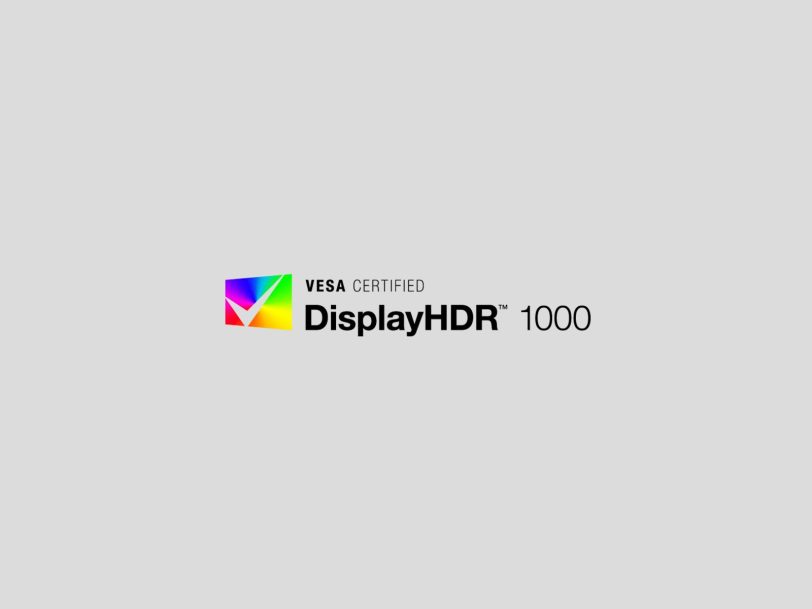What is DisplayHDR 1000?

If you are going to buy a high-end monitor and want to use it for multimedia, it may be useful to know the DisplayHDR 1000 specification. Created by VESA to document certain features on a monitor panel.
You know many certifications are references, which means they cannot be found on monitors as they are deemed unsuitable by manufacturers. However, after the first monitors with DisplayHDR 1000 appeared, we find it right to explain what this VESA certification consists of and why it may be important when we buy a high-end monitor.
What is DisplayHDR 1000?
DisplayHDR 1000 is VESA certified for professionals, performance enthusiasts and content creators. For a monitor to be certified with DisplayHDR 1000, it must meet certain requirements:
- 1000 nits maximum brightness.
- Local Dimming allows to double the contrast of DisplayHDR 600.
- Significant improvement in color space over HDR400.
- 10 bit color depth.
DisplayHDR 1000 requirements
We understand that there are specific questions regarding what has been described, so we will further detail what VESA refers to with these requirements.
Brightness
It can be measured in nits or cd/m², but both measurements are equivalent: 5,000 nits = 5,000 cd/m². This requirement does not mean that the monitor offers a smooth 1000 nits brightness, but it does mean that it will be at its maximum brightness, unable to offer less than 1000 nits for the scenario in question.
What if it doesn’t offer 1000 nits peak brightness? Basically, it cannot be certified with DisplayHDR 1000 as it is a prerequisite.
Local Dimming
Here we have to talk about backlighting. We see that VESA requires a certain Local Dimming, which increases the contrast offered by DisplayHDR 600 monitors by 2x.
What is blackout for VESA? On their website, they specifically explain the importance of LED backlighting to achieve higher contrast ratio: darker blacks and brighter whites. However, they explain it in their own way:
Global Dimming: Consists of a series of LEDs on the edge of the panel that dims that area of the edge. This type of “dimming” has always been referred to as the Edge LED, seen on laptops and most monitors. In return, we manage to consume less energy, but the contrast ratio does not exceed 1000:1.
Local Dimming. The screen is divided into areas or zones where the backlight is adjusted independently. It has sub-orders as follows:
- 1D. The LED chain, like the Edge-LED, but this is controllable, is located on the bottom edge of the panel. Typically, LED arrays have 8 to 16 LED groups -> 8 to 16 dimming zones. In this way, we can see contrast ratios between 6000:1 and 100,000:1. This LED design is most common on TVs and monitors that come with basic HDR.
- 1.5D. It is different in that there are LED arrays on the 2 sides (top and bottom) of the panel, but it is possible to see the same on the sides. This way we have 2 x 16 zones -> 32 blackout zones. However, the upper and lower regions are controlled independently.
- 2D or FALD. The panel is divided into boxes, i.e. full square regions, like a chessboard. In a modern FALD, besides generating a lot of heat, we see zones 384 to 1152 (more is better) and its consumption increasing rapidly. However, it is the best among LED-backlit panels, seeing ratios of 20,000:1 to 500,000:1. All are the most expensive panels.
- Active Dimming. This concept has been adopted by VESA through a verification procedure or monitor testing to ensure that the model that passes the tests can reduce backlight and not through metadata in the video stream. This certification test is called CTS v.1.1: they provide true blackout without changing the metadata.
However, what Native Dimming feature does DisplayHDR 600 offer? And we ask ourselves this question because it has to offer twice the DisplayHDR 1000. We went to the VESA website to see the requirements for DisplayHDR 600 and it only mentions that the dimming technology is “zone level” like the DisplayHDR 1000. Therefore, we concluded that the differences will be in the type of LED backlight.
Color gamut or color space
In this case, we see that VESA has introduced a requirement for DisplayHDR 1000 to improve the color space delivered by DisplayHDR 400, namely sRGB. It’s not specified which actually, but “significant visible increase in color gamut” is achieved, so Adobe RGB, DCI-P3, Rec.2020 etc. We understand that we need to see it on a monitor that meets the space requirements.
Not only is it very interesting to see the other color spaces, but the sRGB coverage is noticeably better than what we saw on the HDR400.
10 bit color depth
This is clearer to us and has to do with the amount of color information available for each pixel. This value is important for color quality, high color accuracy, but above all professional level. The transition from a 9-bit image to a 10-bit image is difficult for the human eye to perceive, but professional monitors for image and video usually have these values.
It should be said that VESA is very serious about this requirement and it is not easy for manufacturers to meet due to the high demands. Similarly, with a good color space, great color depth, accurate backlighting, and the brightness VESA requires for DisplayHDR 1000, they make for an excellent monitor for design.